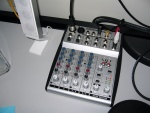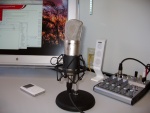Yesterday I posted my first podcast. I thought I'd take a minute to write down how I did it for anyone else so inclined.
Equipment
After asking some friends for advice (like Doug Kaye, Thanks Doug!), I used the following equipment:
|
Behringer Eurorack UB802, an inexpensive 6 channel, 2 mic input mixer.
|
- Behreinger Eurorack UB802 mixer. This is an inexpensive mixer with two mic inputs. Both have phantom power, which is needed to power the mic I used (see below). I spent about $45 on this. There are other options, like the UA-25 USB Audio and MIDI interface which goes direct to USB, avoiding lots cable woes. Its much more expensive and is not a mixer, but its also compact and runs off USB power. Perfect for mobile use. I may pick one up yet.
- Griffin Technology iMic USB Audio Interface. This is not strictly needed if your machine has a line-in port. In any event, I like it because I use USB as a poor man's Powerbook dock and this eliminates two cable plugs.
Behringer B-1 Studio Condenser Mic
- Behringer Studio Condenser Microphone. This is a great mic at a great price. I picked mine up in Orem for less than $90. Its not portable, as you can see from the picture. It comes with a case, shock mount, and wind sock. The stand, I picked up at Radio Shack. I was a little worried about noise from the floor and desk through the stand, but it doesn't appear to be too big a problem. A more portable option would be something like the Shure Sm58.
- Bose Quiet Comfort Headphones. I already had these. You don't need noise reduction for this application. I do think that closed air (i.e. covers the ears) do better at preventing feedback and are more comfortable.
- An Apple Powerbook (1 Ghz with 1G of memory).
All in all, I spent about $150 on equipment I didn't have. You could get by with a cheaper mic that plugs directly into the computer, but I tried that and you can definitely tell the difference. I figured it was worth the $150 to sound a little better since I sound bad enough as it is. :-)
Software
The software set up that I used was Dave Slusher's recipe for OS X podcasting at Evil Genius Chronicles. Dave's recipe is good. I had a few comments:
- Soundflowerbed seems to be very touchy. You use it to get the audio from the Soundflower channel you've set up as a sound bus out to the headphones. I had to start and stop it multiple times to actually get it to route sound and it crashed at times.
- There was a delay from the mic to the headphones that made speaking difficult since you don't hear yourself until a little while after you speak. Consequently, I turned off the headphone feedback when I was speaking. This was OK for soliloquy, but wouldn't work for an interview on the phone.
- Audacity works well, but has a steep learning curve. For someone who's never edited sound before, it was an interesting experience. I'm not above paying money for something if its easier to use. Suggestions?
The one thing I used that's not on Dave's recipe was my hacked version of ListGarden. I used that to create an RSS feed with the enclosure. I could have just put it in my regular RSS feed using Radio, but I decided to create a separate feed for podcasts and ListGarden makes that really easy.
Technique
Here was my technique. Feel free to critique if you've got suggestions that will help be do this better.
- Load the full Gillmor Gang into Audacity. Listen to it and make comments to myself on a label track.
- Go back and re-listen to interesting bits based on my comments. Record the response to them right there on a separate track.
- For each clip (I had 4 or 5), duplicate the original Gillmor Gang track and then cut out the right piece.
- Order the tracks vertically in the order I want to put them in the finished piece. Audacity makes reordering tracks difficult unless I missed something.
- Move them in time so that they follow each other. This is easier to do my compressing time a lot, getting them mostly right, and then expanding time to fine tune the placement.
- Delete unwanted tracks, edit the ID3 info, and export as an MP3.
As I mentioned yesterday, recording this took me about four hours. Dave Slusher took me to task in response to me saying "Recording is hard because when something goes wrong, pretty much the only choice is to start again. You can't easily go back and change one sentence or remove a mispronunciation (at least I can't).":
What the? I do this every time I ever record one. In fact, in tonight's episode I removed about 4 minutes of coughs, stammers and false starts into topics that I decided to abandon. That's over 10% of the final result. This suggests that the real core is in the last part, the "at least I can't" bit. I'm curious to find out what Phil's setup is. Is he using a tool that doesn't have a waveform editor? If so, he could easily use Audacity for free anytime and would have that capability. Or, is this just a case of failing to RTFM? Folks, you can in fact edit the audio, remove mispronunciations or even insert new sentences in place of burbled or erroneous ones. I do it all the time...From Evil Genius Chronicles - No Honor Amongst Systems
Referenced Fri Dec 03 2004 10:28:27 GMT-0700
I'm sure Dave's right, but its just felt like I was swimming in molasses and faced with the prospect of inserting some material in the middle of another clip and removing and repairing several verbal bobbles, it just seemed easier to rerecord it to me. Certainly, as I gain experience with Audacity, that wouldn't be the case, but I don't think you can argue that its as easy as cleaning up text. Text has some very nice properties.
That said, audio has other properties. Doug talks about IT Conversation's ability to give you back bookmarks on audio clips so that you can reference them in a blog. That's nice for somethings, but I wanted to say what I was thinking, not just write them. That's the beauty of podcasting.






